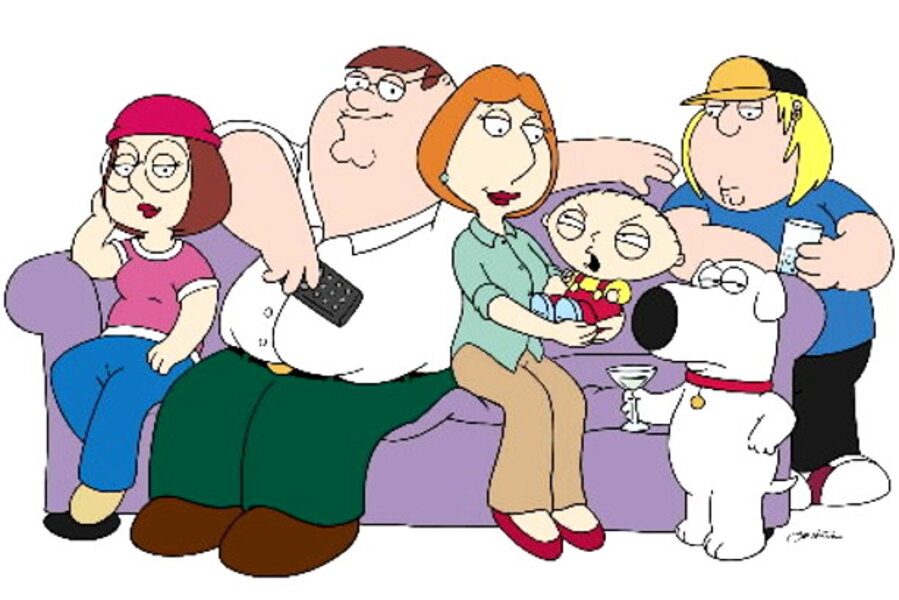Family Guy: Brian bites the dust, but for real?
Loading...
| Los Angeles
Forget nuclear brinkmanship. The question driving serious news hounds this Thanksgiving week is: Will “Family Guy,” the long-running animated TV hit, bring back Brian the dog?
The talking, martini-swilling pooch put four paws up on Sunday night’s episode after being hit by a car. Adding insult to the injury of losing a beloved TV canine is the announcement that "Family Guy" plans to replace Brian with a new pooch named Vinnie, voiced by “The Sopranos” star Paulie “Walnuts” Gaultier.
More than 39,000 fans have already signed an online petition urging the show's creator, Seth MacFarlane, to resurrect the Griffin family pet.
Brian may not sleep with the fishes for long, say TV analysts. After all, this is a postmodern animated sitcom in which baby Stewie once offed his mother, in an episode entitled “Stewie Kills Lois.” Both characters are still around.
“Frankly, this is already a show where a main character is a talking dog who drinks martinis,” says Bob Thompson, founder of the Bleier Center for Television and Popular Culture at Syracuse University in New York. Bringing Brian back from the dead, he adds, would be a walk in the park.
However, if recent TV trends are any guide, fans may be barking up the wrong tree in their bid to revive Brian.
The cognoscente already knew that at least one Griffin family member was a marked man this fall, having been tipped off during this past summer’s Comic Con in San Diego. “We’re going to kill off a member of the Griffin family and replace them with a different character,” showrunner Steve Callaghan told a panel audience in July.
Snuffing out central characters can help to revive interest in programs that are getting a bit long in the tooth, notes historian and pop culture expert Julian Chambliss, from Rollins College in Winter Park, Fla.
“Killing Brian is just a way to make the story more engaging to a media-saturated audience,” he says. “Family Guy" has always played with the idea of death, he adds, “but this moves the show to the forefront of popular conversation.”
Indeed, the show’s ratings are down some 19 percent from this time last year. The need to keep shows relevant to audiences who have more entertainment options than ever trumps most other considerations, says Mr. Chambliss.
“The modern audience has seen everything, so placing these beloved characters in a place that makes us evaluate why we care is the creator's way of reengaging,” he says. Viewers can still be shocked, he adds, because committed fans have come to depend on these characters.
Sometimes viewers know something bad will happen to certain characters because those actors announce that they're moving on to other projects, says Deborah Jaramillo, assistant professor of television studies at Boston University. “Downton Abbey” is one example, she says, citing last season's sudden death of leading man "Matthew." The slow demise of Dr. Green on “ER” was certainly not a surprise, she adds.
But when a character's loss does come as a surprise, it can seem quite cold, she says via e-mail. But it's also “actually pretty riveting.”
“Mad Men,” “The Walking Dead,” “Game of Thrones,” “Dexter,” and others have all done it, says Ms. Jaramillo. The first episode of "Oz" in 1997 “gruesomely dispensed with a character we thought we might follow for a while,” she says.
In fact, she notes, very few characters on TV are entirely protected these days. Even then, consider Tony Soprano's fate in the finale of "The Sopranos," she adds. “This trend can keep viewers in a constant state of anxiety about who will stay and who might go.”
It can also work the other way, Jaramillo says. Sometimes, when a central character should be killed off (see “Dexter”), the network won't allow it.
“There's a financial reason for keeping some characters alive,” she adds.
Prime-time as well as day-time soap operas have a long tradition of killing off main characters and then bringing them back. Consider the infamous return of Bobby on “Dallas,” notes Mr. Thompson.
The point, however, is that TV programming is experimenting. “You don't have to care about this or that character being killed off, but you should care that TV, which has been reviled for so long for being formulaic and predictable, is increasingly shaking things up," says Jaramillo. "Brian simply took one for the team.”
This is a sign of a more dynamic media landscape, agrees Chambliss. It has evolved to embrace both continuity and change, he says. Long-running hits such as the British import “Dr. Who,” now celebrating its 50th anniversary, have demonstrated this: "Dr. Who" has had multiple incarnations of the central character – a move that has enabled the overarching narrative to endure but that has kept the show fresh.
“Law & Order” is among the TV shows that have managed to pull off the same feat, axing some key roles while introducing new ones, says Thompson. The main series ran for two decades. But some shows have failed after a central character's departure, he notes.
“Once Don Knotts left "The Andy Griffith Show," it never really worked,” he says with a laugh.
Whether Brian permanently bites the dust or not, the hands that feed "Family Guy" will certainly milk this moment, says Chambliss.
“I assume the creators for 'Family Guy' will use this as an opportunity to push the story forward and attract new fans,” he says.







